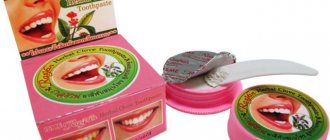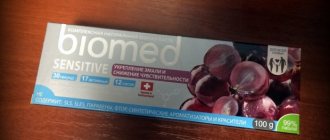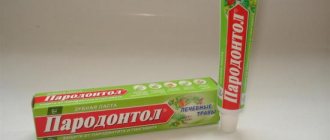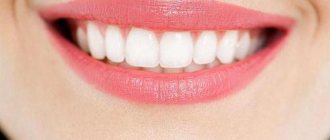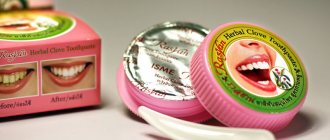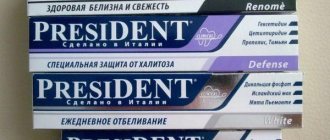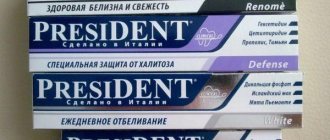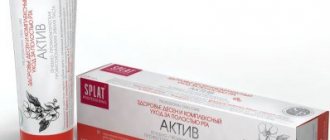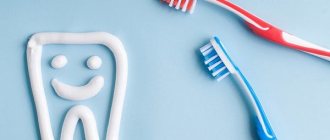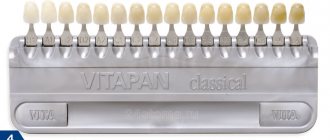In this article we will look at the role that devitalizing paste plays in the world of dentistry.
Devitalization is the killing of the living core (pulp) of a tooth with its subsequent removal. This inevitably leads to death and tooth destruction, since the death of the pulp entails the death of the smallest vessels and nerves present in the dental cavity, which are able to respond to changing conditions.
However, if in living nature everything happens exactly like this, then in the modern world, where teeth turn into design objects, the use of the latest dental techniques allows not only to keep the tooth intact, but also to give it the desired shape. And, despite the fact that there is no life in a tooth without pulp, its physical existence still continues, but only under the condition of constant monitoring and treatment if even the most insignificant changes occur in it.
So, the disadvantage of the pulp removal technique is that a tooth left unattended will inevitably collapse, but the advantage is that the tooth remains in place, preserved both for chewing and for visual aesthetics.
When is such a procedure necessary?
The procedure is also carried out when opening the pulp chamber due to mechanical damage to the tooth or due to inadequate dental interventions. In addition, surgery may be required if it is necessary to prepare teeth for prosthetics, when the likelihood of inflammation developing under artificial structures should be completely eliminated.
Types of pastes
The arsenal of medical products for dental devitalization includes:
- depulping pastes that contain arsenic compounds, as well as devitalizing pastes without arsenic, produced on the basis of formaldehyde;
- using the technique of electrochemical pulp necrosis.
Despite the pronounced toxic effects of arsenic, the need for precise dosing and strict adherence to the period of stay of medical preparations containing it in the pulp cavities, its use for pulp devitalization is quite advisable and justified by many arguments. Devitalizing pastes based on arsenic kill the pulp very reliably, painlessly and quickly.
Technical features of applying paste
The operation to devitalize the dental cavity consists of applying a paste containing arsenic to the open horn of the pulp, which is collected on the tip of the probe. This volume is approximately 40 times less than a pinhead, based on the calculation that the maximum single dose is 3 mg and the maximum daily dose is 10 mg.
After application, the devitalizing paste is covered (without applying pressure) with a piece of cotton wool soaked in an anesthetic solution. The dental cavity is covered with a loose bandage of water dentin, which has a temporary purpose, but ensures absolute tightness of the dental cavity. Taking into account the size of the pulp chamber (depending on the number of tooth roots), the composition is removed from the cavity after 36 or 24 hours, but if chemical periodontitis occurs, the procedure is performed immediately.
Possible reactive pain
The patient is warned in advance about the likelihood of developing short-term (within 2 hours) reactive pain, and is offered to mitigate them with the help of Amidopyrine or bromine preparations.
In addition to quickly passing reactive pain, the use of pastes with arsenic acid compounds threatens the occurrence of severe chemical burns when it is washed out or the cavity is insufficiently sealed, up to necrosis (osteomyelitis). Another consequence of the use of arsenic pastes is the appearance of persistent toxic periodontitis, which is often observed with prolonged and excessive exposure to arsenic.
Thus, in order to avoid damage to the periodontium with the development of foci of necrosis during the use of arsenic, when calculating the dosage and exposure time, the dentist must evaluate such factors as the patient’s age and tooth weight.
Many people are interested in what the effect of devitalizing paste is. Scientific research has proven that the use of adequate dosages of arsenous acid, due to its diffusion into the periapical space, provokes not only the destruction of the dental pulp, but also stimulation of its stump, and also leads to the regeneration of periodontal tissue.
Side effects that may appear after using arsenic paste:
- If the dosage is exceeded, signs of intoxication of the body may appear - nausea, vomiting, diarrhea.
- If the paste is applied poorly, it may be washed out or leaked, accompanied by a burn of the oral mucosa with subsequent complications.
- If the paste is kept in the tooth cavity longer than intended, the dentin may change its color - turn black.
- Due to the high toxicity of the paste, periodontitis may begin.
- Swelling of the pulp due to inflammation.
- The effect of the poison can spread to bone and periosteal tissue, causing their destruction.
Composition of these funds
Arsenic acid (As2O3) is present in arsenic-based devitalizing pastes. Arsenic-free pastes, which are used for pulp devitalization, contain phenol, formaldehyde (formalin) and a combination of their derivatives. In arsenic-free pastes, formaldehyde powder is mixed with creosote, glycerin or petroleum jelly. Their effect is somewhat weaker and less reliable than pastes containing arsenic, and with an insufficient period of exposure, instead of necrosis of the dental pulp, only its mummification (sclerosation) can be achieved. However, the purpose of such manipulation may be precisely this effect: with the amputation technique, in the case of dental therapy in children, the sclerotic pulp, which is left in the microtubules, is aseptic and will no longer cause an inflammatory process.
Such devitalizing pastes include “Paraform”, “Paraformaldehyde”, “Trioxymethylene”, “Formalin”, “Asphalin” and “Triopasta”. The last three drugs are made on the basis of formaldehyde, however, the use of the latter turns out to be more effective when summing up the results of such a dental procedure, because during therapy using amputation techniques, the pulp stump prevents the diffusion of formaldehyde into the periapical spaces.
The use of, for example, asphaline paste most often leads to the development of reactive periodontitis. When using a paste containing paraformaldehyde, lidocaine and phenol, its effect lasts from 5 to 8 days, but has a lighter effect, without irritation or disruption of periodontal structures. There are no specific features when applying paraformaldehyde pastes - they are the same as for arsenic pastes.
Various manufacturers produce both arsenic-free devitalizing pastes and those with arsenic in their composition, which make it possible not only to achieve the expected effect, but also to plan a schedule for the patient to visit the dental office. For example, the use of “Devit-A” paste, which has a pronounced anesthetic effect, helps relieve severe pain during the treatment of acute pulpitis, “Devit-P” - to achieve mummification of the pulp of milk teeth and prevent its extirpation, and “Devit-S” - to use by the method of mortal amputation or exirpation in the treatment of residual symptoms of root pulpitis, both in temporary teeth and permanent ones.
History of the creation and use of arsenic paste in dentistry
M. A. Egorova, student of the State Educational Institution of Higher Professional Education "Kazan State Medical University" of Roszdrav, Department of Therapeutic Dentistry
L. R. Mukhamedzhanova Doctor of Medicine, Associate Professor, Head of the Department of Therapeutic Dentistry, Kazan State Medical University, Roszdrav, Department of Therapeutic Dentistry
More than four centuries ago, the German alchemist, philosopher and occultist Theophrastus Guggenheim, known as Paracelsus, proposed the use of arsenic and its compounds to treat various diseases. From this time on, perhaps, the difficult “medical fate” of arsenic compounds, full of dramatic moments, began. At the same time, their biological effects are being actively studied. Already by the middle of the 17th century, prescription recipes were developed that included arsenic acid and were intended for the treatment of blood diseases, infectious diseases, etc. Dentists did not stand aside, for whom the problem of anesthetizing the inflamed pulp was a kind of “pain point”.
Modern specialists involved in endodontics use numerous arsenic preparations to devitalize the pulp, while opinions about the advisability of their use are often diametrically opposed. Therefore, it seems to us very relevant to study the historical aspects of the creation and use of arsenic paste in dentistry.
The material for the study was excerpts from dental manuals of the 17th-20th centuries and a historiographic description of the development of dentistry.
Analysis of the source base suggests that arsenic was used in the treatment of damaged teeth around 500 BC. e., as recorded in the book of Zhu-Qing. However, after this and until the 19th century, no further mentions have been found. In the first half of the 19th century, the ideas of J. Hunter finally began to be realized: attempts were made to remove the pulp with a thin serrated instrument after cauterizing it with acid. The nerve was removed with a trephine, needles, or a special hand-held trocar instrument. The pulp continued to be cauterized for the purpose of preliminary anesthesia for such interventions. However, at the same time, a tool was introduced into endodontic practice that significantly changed its character: in 1836, the American dentist Shearjashub Spooner, in his work “The Path to Healthy Teeth, or a Popular Treatise on Teeth,” described a method of “killing the nerve” with arsenic acid (albeit without its subsequent removal). It was recommended to mix arsenous acid with morphine sulfate. Today this fact will seem surprising to us, since in the times described there were no restrictions on the use of narcotic analgesics. In 1872, in the article “What shall we do with a baby tooth in which the pulp is subject to decay?” (“What shall we do with deciduous teeth in which the pulps are exposed?”) it was proposed to apply an arsenic drug, followed by removal of the coronal pulp and filling the cavity of the temporary tooth. The author considered it necessary to warn parents about the possibility of “... the development of periostitis, then alveolar abscess,” after which (!) “no serious problems arise.” German scientist Ad. Witzel (1874) notes that the use of arsenous acid “created a new stage in the study of dental diseases.”
The practical use of arsenic paste is described by Yu. Sheff in the “Manual of Dental Diseases” (1882). To eliminate toothache, he suggests using arsenic paste and carbolic acid. Gives several recipes containing narcotic analgesics for local anesthesia in direct contact with the exposed pulp: tincture of opium; tincture consisting of morphine, alcohol and chloroform; pills containing creosote. After preparing the latter, it was recommended to “put it on cotton wool on the painful cavity.”
J. Parreidt (1890) suggests using arsenic paste for pulp inflammation and also as an anesthetic: “Remove the filling, cauterize and scrape out the tooth pulp.” For cauterization, the author recommends arsenic, to which a small amount of carbolic acid is added; iodoform is used instead of morphine. Parreidt used a cauterizing agent with the following composition:
- Rр. Acid. arsenicosi.
- Pulv. Jodoform. pur. alcoholisat.
- Acid. carbolic. pur. ana.
For the first time, restrictions on the use of arsenic acid were introduced only in 1898 by WD Miller in a manual on conservative dentistry. He pointed out that “... arsenous acid should not be used in children, their teeth are usually too rotten and soft, and the foramen apicale is mostly too wide, or part of the root apex has already been reabsorbed. Under such conditions, it can easily happen that the arsenic paste will have an effect on the root sheath.” The next blow to the use of arsenic paste came from the Board of Drugs of the American Dental Association (Ada, 1961). The main disadvantage of “irreversible devitalizing anesthesia” is the toxic effect on the periodontium. Due to the technical complexity of dosing, the likelihood of periodontal damage is very high. In addition, the carcinogenic effect of arsenic drugs did not lose relevance.
In the 20th century, arsenous acid (anhydride) began to be used in the form of a paste. To formulate the paste, medicinal substances with anesthetic and antiseptic properties were added to the acid, as well as agents that slow down the diffusion of arsenic into the pulp tissue and thereby weaken its toxic effect. For this purpose, novocaine, carbolic acid, tannin, iodoform, clove, camphor oils, and glycerin were used. E. M. Gofung and I. G. Lukomsky (1936) recommend adding tannin and cinnamon oil to the arsenic paste, which simultaneously promotes mummification of the cauterized pulp. The presence of morphine or cocaine in the paste is designed to make the pulp less sensitive during the devitalization process, but many consider their effect to be very questionable. Adding creosote or carbolic acid to the paste causes a burn of the pulp followed by a scab and interferes with the rapid absorption of arsenic.
The literature mentions the use of tiled arsenic for pulp devitalization. Its effect is gentler than arsenic, and most importantly, it does not cause complications on periapical tissues. However, tile arsenic is nothing more than cobalt, the action of which is fundamentally different from the action of arsenous acid.
In 1927, Mủller made an extraordinary instruction: “...pulps extirpated after devitalization with arsenic paste turned out to be sterile.” This new circumstance significantly increased the value of arsenic. However, today it is known that arsenic itself does not have bactericidal properties. The substances that make up the arsenic paste are important here: phenol, creosote, etc.
Considering that arsenous acid is a strong protoplasmic poison, it is necessary to strictly adhere to the dosage of the paste depending on the size of the tooth, the condition of the pulp, the age of the patient and the choice of treatment method for pulpitis. However, the dosage of arsenic paste caused a lot of controversy. Later they came to the conclusion that it is enough to leave 0.0002-0.0004 g of arsenic acid in single-rooted teeth for 24 hours, and in multi-rooted teeth for 48 hours. One of the main conditions for applying the paste is direct contact with the pulp tissue. A. I. Rybakov (1980) about.
To date, the mechanism of action of arsenous acid on pulp has been studied in detail. Being a protoplasmic poison, arsenous anhydride primarily affects the oxidative enzymes of the pulp, leading to local disruption of tissue respiration and hypoxia. Under the influence of even the smallest amount of arsenic, the oxidase loses its specific functions as an oxidation enzyme. In addition, arsenic blocks thiol compounds that function as respiratory coenzymes. The symptom complex of the effect of arsenic on the pulp is characterized by changes in the vascular system. Already 2-2.5 hours after the start of devitalization, hyperemia develops, the vessels, especially the capillaries, are sharply dilated, then numerous hemorrhages appear, which depend on changes in the walls of the vessels and the loss of their resistance. Swelling causes compression of the pulp tissue. The nerve fibers of the pulp undergo granular disintegration of the myelin sheaths, nodular swelling and disintegration of the axial cylinder. Varicose nerve fiber is replaced by its death. Changes in all groups of cellular elements of the pulp come down to the phenomena of karyorrhexis and cell death, primarily odontoblasts. The depth of pulp damage is directly related to the duration and dose of arsenous acid. At the site of application of arsenous acid, a picture of the death of all elements of the coronal pulp is observed.
As for those cases when arsenic paste does not have a sufficient effect, they are explained by the presence of denticles in the pulp, which do not allow arsenic to pass through themselves and are an insurmountable obstacle for it. In such cases, E.M. Gofung and I.G. Lukomsky (1936) recommend removing the denticles and reapplying the arsenic paste.
Successfully performed devitalization ensures demarcation between the necrotic pulp and the periodontium, resulting in the creation of conditions for the release of the pulp from the canals with minimal bleeding and, consequently, for the healing of the surgical wound after extirpation.
Currently, a huge number of dosage forms intended for professional use in dentistry are appearing on the domestic and foreign pharmaceutical market. And arsenic preparations for pulp devitalization also did not go unnoticed by the research laboratories of leading enterprises producing dental materials. Arsenic paste began to be produced in doses, in the form of granules of various colors, depending on the required timing of application of the paste (green, blue, etc.). Sometimes a filler in the form of threads of different colors (or cotton wool) is added to the arsenic paste for the correct dosage, which greatly facilitates their use in various clinical situations.
Thus, based on an analytical review of literature sources, we consider it appropriate to distinguish three stages in the history of the use of arsenous anhydride in the treatment of pulpitis. The 1st stage (500 BC - the beginning of the 19th century) is characterized by the use of arsenic anhydride without the addition of narcotic analgesics, antiseptics and consistency substances. At the 2nd stage (mid-nineteenth century - mid-twentieth century), arsenic anhydride is included in multicomponent pastes containing analgesics, mummifying drugs, and consistency substances. The 3rd stage (from the mid-twentieth century to the present) is characterized by the use of dosed, prolonged preparations, allowing for an individual approach to dose selection and determining the duration of the period of pulp devitalization.
- Baume R. Guide to dental diseases / R. Baume. - M.: 1897. - P. 321.
- Gofung E. M. Clinic of diseases of teeth and oral cavity. Guide for doctors and students / E. M. Gofung, I. G. Lukomsky. - State Medical Publishing House of the Ukrainian SSR, 1936. - pp. 360–388.
- Ivanov V. S. Practical endodontics / V. S. Ivanov, G. D. Ovrutsky, V. V. Gemonov. - M.: Medicine, 1984. - P. 82, 145.
- Rybakov A.I. Clinic of therapeutic dentistry. 2nd ed. / A. I. Rybakov, V. S. Ivanov. - M.: Medicine, 1980. - 318 p.
- Stolyarenko P. Yu. History of pain relief in dentistry (part 1). Monograph / P. Yu. Stolyarenko. - Samara, 2001. - pp. 66–78.
- Khomenko L. A. Medical interventions in the root canals of temporary teeth. Part 1. To treat or not to treat?/L. A. Khomenko, N.V. Bidenko, A.I. Zelenkova // Modern dentistry. — 2008, No. 1 (41). — P. 99–109.
- https://www.krugosvet.ru/enc/nauka_i_tehnika/himiya/MISHYAK.html
- https://www.dentoday.ru/ru/content/archive/2001/11/14/
- https://biodent.com.ua
Devitalizing paste "Devit"
As noted above, this brand of paste comes in three types and is used in various dental methods of dental therapy. It is used for pulp devitalization in the treatment of pulpitis during mortal amputation or extirpation, for the treatment of residual pulpitis, and is also used as an additional means for devitalization during repeated procedures after using devitalizing pastes containing arsenic.
Paraformaldehyde paste - mechanism of action, advantages of use
Paraformaldehyde paste is applied to the tooth for a longer period than arsenic paste. Instead of wearing arsenic paste for a maximum of 48 hours, the patient should undergo paraformaldehyde for 10-14 days. However, this method of devitalization is considered more gentle on the body, since this paste is less toxic. It does not have such an aggressive effect on periodontal tissue as does containing arsenic. This paste promotes the death of pulp vessels and the cessation of its blood supply, but does not cause pathological changes in the periodontium even with prolonged use.
Paraformaldehyde also has a mummifying effect on dying pulp. It “pulls” moisture from the pulp, causing it to dry out.
If it is necessary to devitalize the pulp of a tooth with unformed roots, use only paraformaldehyde paste.
What does arsenic-free paste contain?
This arsenic-free paste contains:
- paraformaldehyde, which is an antiseptic that coagulates albumin and provides pulp devitalization;
- fiberfill;
- paste former;
- lidocaine hydrochloride, an anesthetic and reducing the risk of painful symptoms.
The use of Devit pastes ensures long-term devitalization of the pulp without irritation and pain, eliminating the need to re-treat the canals in order to neutralize arsenic salts, as when using arsenic pastes. Devitalization of the pulp occurs in 3-5 days, sometimes in 7 days. If the patient does not feel pain, filling can be done within 48 hours after using this devitalizing paste. The effectiveness of this drug is maximum today, especially when compared with arsenic-based pastes.
Arsenic devitalizing paste consists of the following components:
- Arsenic anhydride.
- Elements that have an antiseptic and disinfecting effect on the pulp.
- Pain relieving components.
- Components that ensure long-lasting action of the paste.
- Additional components.
Arsenic in any form is one of the most potent poisons. A dose of 5 mg is toxic for humans, and therefore for devitalization the permissible maximum dose is 3 mg.
If the dose is exceeded, symptoms of intoxication such as vomiting and loose stools may occur.
When arsenic paste is applied to the pulp, gradual necrosis of nerve endings and blood vessels occurs. Since the blood supply is cut off, the pulp dies and the transmission of nerve impulses stops.
Many dentists prefer not to use arsenic paste for devitalization, especially when treating children, pregnant and nursing mothers. Moreover, there are safer and less toxic analogues.
Reviews of these pastes
There are relatively few reviews of devitalizing pastes on medical websites, and they are left mainly by dental specialists who use such drugs in daily clinical practice. Dentists say that arsenic pastes are more reliable, but they are very dangerous to health and are not used in the treatment of children's teeth. Arsenic-free drugs such as Devit are the most popular, even though they do not have such strength. However, according to dentists, they do an excellent job with their main task, and in addition they effectively relieve pain, which is very important in dental therapy. Today they are most often used in dentistry.
